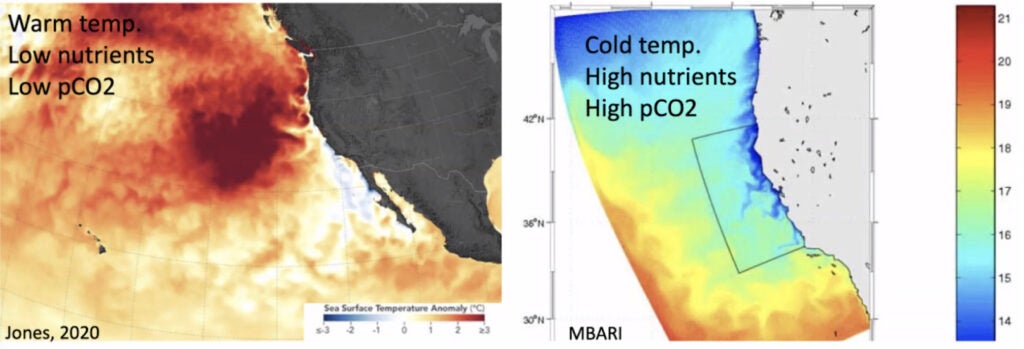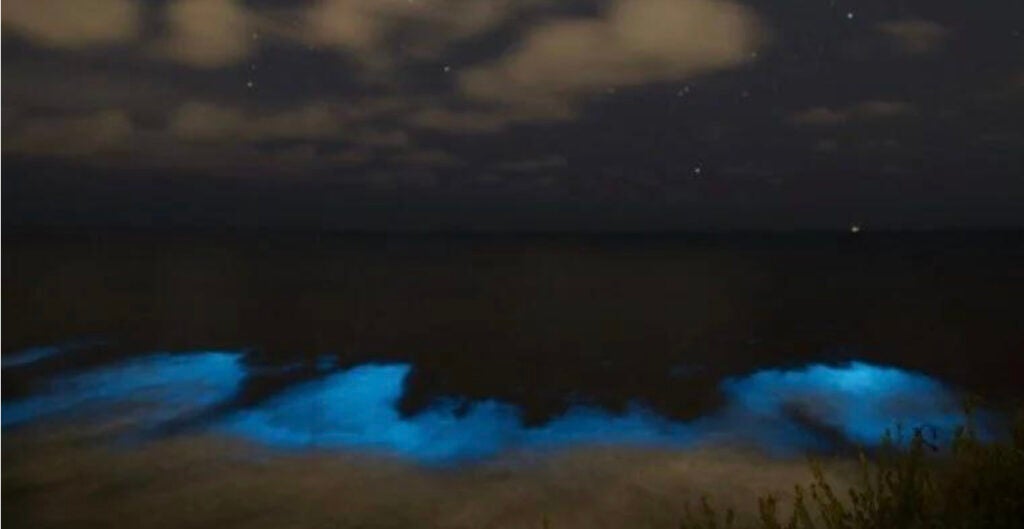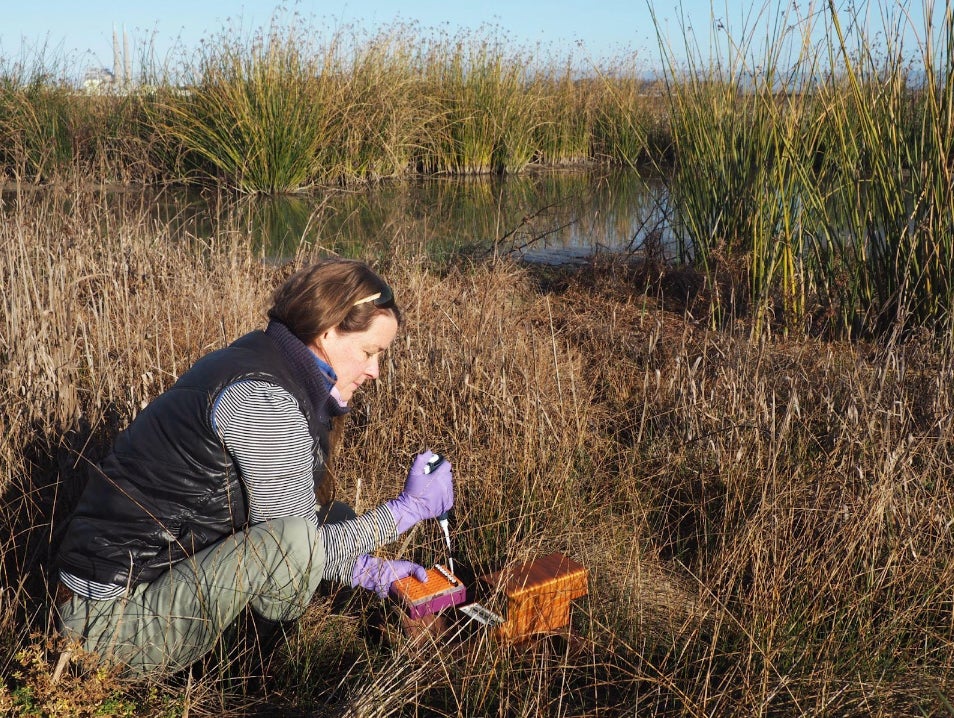
A Ticking Toxic Time Bomb
Between 2014 and 2015, a “blob” of record-breaking warm water traversed the west coast of the U.S., gaining media attention as the warm temperatures wreaked havoc on the bottom of the food chain, causing fisheries like sockeye, pink, and coho salmon to collapse and thousands of sea lions and sea birds to starve. However, amid this devastation, one microscopic creature thrived or “bloomed”—a neurotoxin-producing diatom called Pseudo-nitzschia—causing devastating multi-million dollar losses for many West Coast commercial and tribal crab and shellfish fisheries that had to shut down due to the risk of toxin-contaminated seafood. The toxin produced by Pseudo-nitzschia, domoic acid, can cause amnesic shellfish poisoning in humans, with symptoms like vomiting, diarrhea, headache, loss of short-term memory, motor weakness, seizures, and irregular heart rhythms.
Beyond the clear ecological and economic devastation, this 2015 blob-associated harmful algal bloom also left the scientific community in shock. The prevailing understanding was that toxic Pseudo-nitzschia blooms were associated with nutrient-rich, cold-water pulses of water seasonally brought up or “upwelled” from the depths along the Pacific west coast. With the massive hot blob of water hovering over the coastline in 2015, there was little to no upwelling. So how did a toxic bloom occur during this massive heatwave?

This mystery was irresistible to Dr. Kyla Kelly, who at the time was a University of Southern California (USC) Sea Grant-funded doctoral candidate studying harmful algal bloom formation and toxicity in a changing climate in the lab of Professor David Hutchins at USC. Kyla immediately realized that the answer to this mystery would not be a simple cause-and-effect solution. The scientific literature was already filled with research on Pseudo-nitzschia focusing on single factors, such as how temperature alone affects the diatom. “Given that climate change will alter more than just temperature,” said Kyla, “I knew we had to look at how combinations of factors would impact Pseudo-nitzschia blooms.”
Harmful algal blooms (HABs) are not a new phenomenon, but they have gained considerable attention in recent years as their size, duration, and toxicity have increased. Multiple species of phytoplankton (i.e. microscopic photosynthesizing algae) can form a bloom, which is simply a rapid population expansion, often on the order of days, that sometimes is visible in the form of a “red tide” or glowing waves in the dark.
Not all algal blooms are toxic, though. Only some, like Pseudo-nitzschia, produce toxins. Even then, it is complicated. Of the 58 known species of Pseudo-nitzschia, only about half produce toxins, but scientists still don’t understand exactly when and why. Moreover, even the species that do not produce toxins can cause ecological and economic damage by rapidly using up vast amounts of oxygen in the surface waters of the ocean, sometimes causing massive fish kills.

Through intricate experiments using multiple variables, Kyla’s dissertation research, which was just published in 2023 in the journal of Harmful Algae, tested multiple variables simulating both marine heatwave and cold-upwelling conditions for Pseudo-nitzschia in a laboratory setting. “Blooms now have been associated with both extremes, each with completely different conditions,” said Kyla, “so we had to figure out the mechanisms for both.”
Kyla’s intricate experiments balancing many cultures of Pseudo-nitzschia with various tweaks in temperature, nutrients, and carbon dioxide eventually illuminated the importance of nitrogen in triggering this diatom’s killer side, especially in warmer temperatures. Extreme heat (22o C)—even beyond what was measured during the 2015 “blob”—inhibited the ability of the diatom to bloom, but “normal heatwave” temperature (19o C) allowed the diatom to bloom, although with minimal toxic domoic acid production. However, when Dr. Kelly added nitrogen to the heatwave conditions, she was able to reproduce the massive toxic bloom that plagued the west coast in 2015.
In marine heatwave conditions, there are virtually no nutrients being upwelled from the deep cold waters off the coast. So how did the Pseudo-nitzschia suddenly get that final missing ingredient of nitrogen to flip to the dark side and begin sending domoic acid up the food chain? Kyla and other scientists now believe there was some nutrient input from upwelling along the coastal edge of the blob, just enough to ignite the Pseudo-nitzschia ticking time bomb.
However, now aware of what a little dash of nitrogen could do in a warm coastal ocean, Kyla and her fellow researchers are concerned about potential anthropogenic inputs of nitrogen from land-based sources, which can happen year-round in the form of agricultural, stormwater, or wastewater run-off. “This is why it is important to set regulations for how much nitrogen we are dumping in the water,” said Kyla. Work like Dr. Kelly’s illuminates the importance of local, regional, and state priorities to minimize nitrogen run-off from land.

Understanding what factors—or combination of factors—can trigger a massive toxic bloom could give scientists and fishery managers better predictive abilities to warn commercial fisheries and tribes to harvest early before a toxic bloom occurs, saving millions of dollars. It also could help managers and rescue agencies prepare for impacts on marine mammals, such as mass strandings or aggressive behavior.
Harmful algal bloom expert, Dr. Vera Trainer, who is the University of Washington’s Marine Program Director and Research Scientist at the Olympic Natural Resources Center, says that Kyla’s work “brings to light the environmental controls on toxicity for one of the most harmful phytoplankton species on the US west coast, which causes millions of dollars of damage to the Dungeness crab and other fisheries—her research will enhance the predictability of harmful Pseudo-nitzschia blooms to preserve these shellfish harvest opportunities.” Before her position at the University of Washington, Dr. Trainer was at the National Oceanic and Atmospheric Administration’s (NOAA) Northwest Fisheries Science Center working to develop a regional prediction or warning system for harmful algal blooms.
Beyond Kyla’s groundbreaking work, USC Sea Grant has recently funded several other research projects working to better understand harmful algal blooms off the California coast. USC Sea Grant funded work by Dr. Bradley Moore and Dr. Andrew Allen from the University of California San Diego, in collaboration with Kyla’s advisor, Dr. Hutchins at USC, identified, for the first time, clusters of genes responsible for domoic acid production, resulting in a publication in the prestigious journal of Science.
USC Sea Grant also funded work by Dr. David Caron, Dr. Avery Tatters, and Dr. Eric Webb of USC documenting multiple toxins in cyanobacteria, a primitive type of algae, that often lives in freshwater or brackish (a mix of fresh and salt water) in California’s estuaries. Dr. Caron’s team established a culture collection of cyanobacterial species for other researchers, created publicly accessible maps on the presence of cyanobacteria and cyanotoxins in a variety of water bodies in Southern California, and participated in an expert state workgroup to develop a Framework for Monitoring and Assessment of California Freshwater Harmful Algal Blooms.
Finally, USC Sea Grant is funding Dr. Holly Bowers and Dr. Jason Smith of San Jose State University who have successfully pioneered the use of new portable detection technology to allow for almost real-time, onsite detection of harmful algal species. This would allow for results on a management-relevant timeframe, allowing for earlier warnings to fishermen and the public.

Oceanographers and climatologists predict that coastal California will experience more frequent and more intense extremes of both cold-water upwelling and marine heatwaves. Because of Kyla’s recent doctoral research, we now know that the California coast is not safe from toxic Pseudo-nitzschia blooms in either scenario. Given the right inputs, the diatom can form ecologically and economically devastating blooms in either heatwave or cold-upwelling scenarios.
Even with this important piece of the puzzle, there is more work to be done. As Kyla points out, “different species of Pseudo-nitzschia may respond differently to various combinations of factors,” so her beautifully designed, intricate experiments can serve as a model for future research.
USC Sea Grant will continue to prioritize harmful algal bloom research that considers the backdrop of climate change’s effects on California’s coastal waters and produces results that can immediately help improve the management of our fisheries and our ecologically and culturally important ecosystems.